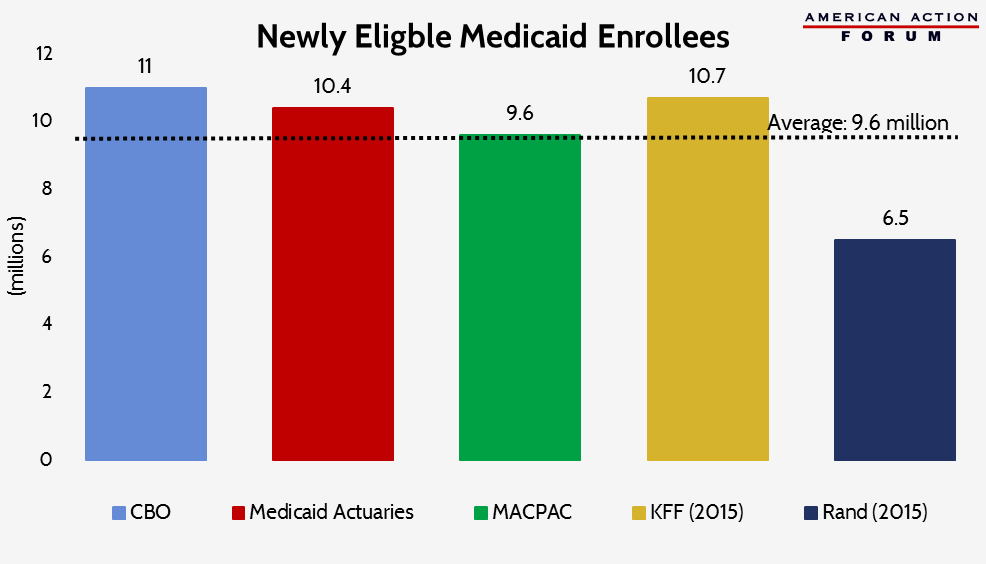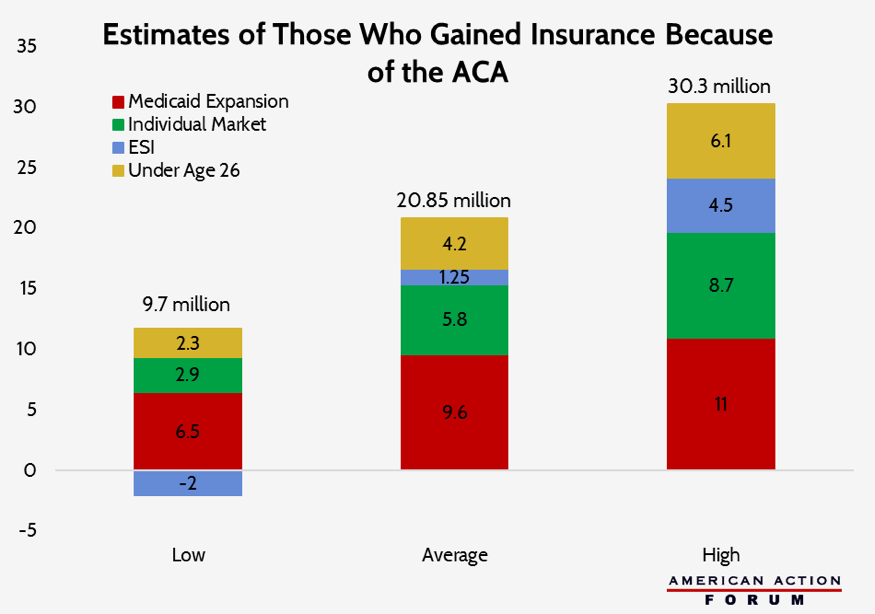Insight
January 4, 2017
How Many Are Newly Insured as a Result of the ACA?
Introduction
The Department of Health and Human Services (HHS) recently announced that 20 million people are newly insured as a result of the Affordable Care Act (ACA).[i] This has led many to espouse claims that, accordingly, 20 million people would lose their health insurance if the ACA is repealed. However, much research has been done to determine who these 20 million individuals are, what type of insurance they now have, and whether they were uninsured before the ACA or if they have just transitioned from one insurance pool to another.
According to the HHS report, 17.7 million people are newly insured since October 2013 (primarily through the Exchanges and Medicaid), and 2.3 million are young adults who benefitted from the provision allowing them to remain insured as a dependent on their parents’ health insurance until age 26, which took effect in 2010.[ii]
However, many of the newly insured were not and are not dependent upon the ACA for continued coverage. As American Action Forum (AAF) expert Robert Book points out, it is certainly reasonable to assume that some of the 2.3 million young adults would have found other insurance if not for the ACA provision, such as enrolling in their own employer-sponsored insurance upon finding a job. An estimated 4.9 million individuals now enrolled in Medicaid were previously eligible for the program. Of the estimated 5.8 million newly insured in the individual market, at least 1 million are not receiving ACA subsidies. While some have gained employer-sponsored insurance (ESI), as many as 5.9 million may have lost ESI because of the ACA.
Medicaid Expansion
More than 14.5 million are newly enrolled in Medicaid, and AAF estimates that 9.6 million of these individuals are newly eligible as a result of the Medicaid expansion provision, which has been implemented by 31 states and the District of Columbia. Most Medicaid enrollment expansion has occurred in the expansion states, though not all of the newly enrolled, even in the expansion states, are adults newly eligible for Medicaid.
In March 2016, HHS reported that 12 million new Medicaid enrollees lived in states that had expanded Medicaid, though not all were necessarily newly eligible, and another 2 million lived in states that had not expanded.[iii] In the same month, the Congressional Budget Office (CBO) estimated 11 million Medicaid enrollees in 2016 were made eligible for Medicaid by the ACA.[iv] The Medicaid Actuarial Report estimates that 11.9 million people have newly enrolled in Medicaid between 2013 and 2016, and roughly 10 million of these individuals are newly eligible.[v]
MACPAC reported in October 2016 that 13.3 million more people were enrolled in Medicaid since September 2013; 9.6 million of these individuals are part of the newly eligible population, though more than 3 million of them were eligible for Medicaid prior to 2014 due to waivers that certain states had obtained.[vi] Kaiser reported that as of 2015, nearly 14.1 million people had enrolled in Medicaid since the expansion took effect, with 10.7 million of those individuals being newly eligible and the remaining 3.4 million people being eligible prior to changes made by the ACA.[vii] One year later, Kaiser now estimates that an additional 2.6 million people have enrolled in Medicaid, though it is not clear how many they estimate to be newly eligible.[viii]
In 2015, RAND found 12.6 million people newly enrolled, 6.5 million of whom were previously uninsured.[ix] The Foundation for Government Accountability found that among just 24 of the states that have expanded Medicaid, enrollment had increased by more than 11.5 million; these states had estimated enrollment to only increase by 5.5 million.[x] A study by Jonathan Gruber and colleagues found significantly different results, though this may largely be the result of how individuals were classified. Gruber, et al, found 44 percent (8.8 million) of the coverage gains made since enactment of the ACA were among people who were previously eligible for Medicaid, while only 19 percent (3.8 million) of the gains were among newly eligible Medicaid enrollees. However, in this study, people were counted as previously eligible if their state had expanded eligibility through a waiver prior to the enhanced federal match taking effect in 2014, which is not how the other studies defined “previously eligible” and significantly alters the results.
Of the studies that specifically estimated the number of individuals newly eligible for and enrolled in Medicaid (excluding the Gruber study), the average estimate is 9.6 million; including the Gruber study brings the average down to 8.7 million.
Individual Market
The remaining 8.1 million must be individuals who have enrolled in coverage in the individual market either on or off the Exchanges, and individuals newly enrolled in employer-sponsored insurance. McKinsey found 26 percent of individuals (or approximately 2.1 million) enrolled in Exchange plans in 2014 were previously uninsured.[xi] Assuming this percentage still holds, it translates to roughly 2.9 million people in 2016. In 2015, RAND found 4.1 million enrolled in the Exchanges, and 1.2 million enrolled off the Exchange, were previously uninsured.[xii] A Kaiser study from 2014 found that 43 percent of all individuals enrolled both on- and off-Exchange were previously uninsured; applying this percentage to 2016 results in an estimated 8.7 million people enrolled in non-group coverage were previously uninsured.[xiii]
CBO estimates 9 million individuals are currently enrolled in plans purchased off the exchange, and Charles Gaba estimates 7.1 million.[xiv] Practically speaking, though, no one enrolled in off-Exchange plans would be affected by repeal of the ACA since they are not receiving subsidies. However, it is estimated that 1.5 million of these individuals are eligible for subsidies but for unknown reasons are purchasing off the Exchange.[xv] In short, the estimates regarding the number of people currently enrolled in the individual market who were previously uninsured range from 2.9 million to 8.7 million.
Employer-Sponsored Insurance
Regarding the employer market, RAND estimates 9.6 million gained insurance through their employer between 2013 and 2015, though it is likely that many of these individuals would have enrolled in ESI without passage of the ACA.[xvi] Further, RAND found 5.9 million lost coverage; it is likely that most of these individuals lost employer coverage, which puts the net ESI gain closer to 4 million. CBO estimated that 2 million fewer would be enrolled in coverage through their employer in 2016 because some employers are no longer offering coverage, Medicaid crowd-out, and the repeal of the auto-enrollment provision.[xvii]
Conclusion
The chart below shows the estimates of the number of people that are newly insured as a result of various provisions of the ACA. While the average estimate shows 20.85 million people have benefitted from the ACA, it is important to note that some people currently enrolled in Medicaid could have enrolled in Exchange coverage with nearly full subsidization had their state not expanded Medicaid, and would very likely be eligible for whatever new subsidy structure might replace the current system. Many of those benefitting from the “under age 26” provision likely have offers of insurance of their own that they are currently forgoing because it is easier to have their parents pay their premiums. Regarding those in the Individual Market, not all of these individuals are receiving subsidies and would therefore not be financially impacted by the repeal. Finally, at least a few million people are believed to have lost their employer coverage as a result of the ACA, particularly the cost and complexity of the many new regulations. Ultimately, the number of people likely to be negatively impacted by a repeal of the ACA is certainly less than 20 million. Making reasonable assumptions and accounting for those who lost insurance because of the ACA, and setting aside any assistance that would be provided by ACA replacement policies, the number of people who, on net, are potentially at risk of being negatively impacted is likely closer to 13-14 million.
[i] https://aspe.hhs.gov/sites/default/files/pdf/187551/ACA2010-2016.pdf
[ii] Some of the 17.7 million, 3.8 million are young adults, some (but not all) of whom are also benefitting from the “under 26” provision.
[iii] https://aspe.hhs.gov/sites/default/files/pdf/187551/ACA2010-2016.pdf
[iv] https://www.cbo.gov/sites/default/files/114th-congress-2015-2016/reports/51385-HealthInsuranceBaseline_OneCol.pdf
[v] https://www.cms.gov/Research-Statistics-Data-and-Systems/Research/ActuarialStudies/Downloads/MedicaidReport2015.pdf
[vi] https://www.macpac.gov/subtopic/medicaid-enrollment-changes-following-the-aca/
[vii] http://kff.org/other/state-indicator/medicaid-expansion-enrollment/?currentTimeframe=0
[viii] http://kff.org/health-reform/state-indicator/total-monthly-medicaid-and-chip-enrollment/?currentTimeframe=0
[ix] http://www.rand.org/news/press/2015/05/06.html
[x] https://thefga.org/download/ObamaCare-Expansion-is-Shattering-Projections.PDF
[xi] http://healthcare.mckinsey.com/sites/default/files/McKinsey%20Reform%20Center_Individual%20Market%20Post%20OEP%20Trends.pdf
[xii] http://www.rand.org/pubs/external_publications/EP50692.html#relatedProducts
[xiii] https://kaiserfamilyfoundation.files.wordpress.com/2014/06/8306-t2.pdf
[xiv] http://acasignups.net/16/09/09/guess-what-several-million-exchange-enrollees-appear-qualify-exchange-subsidies
[xv] http://acasignups.net/16/09/09/guess-what-several-million-exchange-enrollees-appear-qualify-exchange-subsidies
[xvi] http://www.rand.org/pubs/external_publications/EP50692.html
[xvii] https://www.cbo.gov/sites/default/files/114th-congress-2015-2016/reports/51385-HealthInsuranceBaseline_OneCol.pdf












